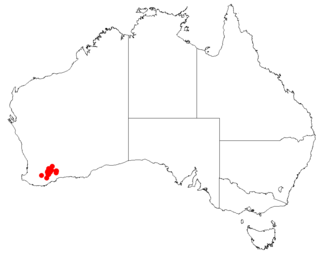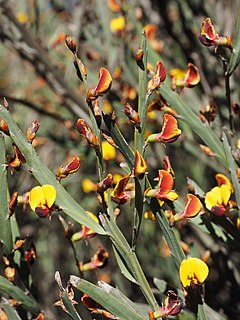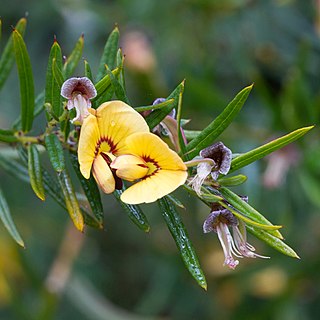Bossiaea vombata, commonly known as wombat bossiaea, is a species of flowering plant in the family Fabaceae and is endemic to the Wombat State Forest in Victoria, Australia. It is an erect shrub with flattened cladodes and yellow, pea-like flowers.

Bossiaea obcordata, commonly known as spiny bossiaea, is a species of flowering plant in the family Fabaceae and is endemic to south-eastern continental Australia. It is an erect, rigid shrub with spiny branches, heart-shaped to egg-shaped with the narrower end towards the base, and yellow and purplish-brown flowers.

Bossiaea tasmanica is a species of flowering plant in the family Fabaceae and is endemic to Tasmania. It is a prostrate or low-lying shrub with spiny branches, elliptic to egg-shaped with the narrower end towards the base, and yellow and red to pink flowers.

Bossiaea halophila is a species of flowering plant in the family Fabaceae and is endemic to Western Australia. It is a dense, erect, many-branched shrub with narrow-winged cladodes, leaves reduced to small scales, and yellow-orange and deep red flowers.

Bossiaea bombayensis, commonly known as bombay bossiaea, is a species of flowering plant in the family Fabaceae and is endemic to a small area of New South Wales. It is an erect shrub with flattened cladodes, small, scale-like leaves, and pea-like yellow to red flowers.

Bossiaea concolor is a species of flowering plant in the family Fabaceae and is endemic to eastern Australia. It is an erect shrub with elliptic to oblong or egg-shaped leaves with the lower end towards the base, and yellow and red flowers.
Bossiaea flexuosa is a species of flowering plant in the family Fabaceae and is endemic to Western Australia. It is a compact shrub with slightly flattened, zigzag branches, notched, more or less leafless cladodes, and golden yellow and red or pinkish flowers.

Pultenaea grayi, commonly known as Murrumbidgee bossiaea, is a species of flowering plant in the family Fabaceae and is endemic to the Australian Capital Territory. It is an erect shrub with flattened, winged, glabrous cladodes, leaves reduced to small scales, and pea-like, yellow and red flowers.
Bossiaea laxa is a species of flowering plant in the family Fabaceae and is endemic to a small area near Norseman in Western Australia. It is a spreading, openly-branched shrub with linear to narrow oblong leaves, and bright yellow and red flowers.

Bossiaea leptacantha is a species of flowering plant in the family Fabaceae and is endemic to southern Western Australia. It is a low, compact, spreading, many-branched shrub, the branches ending in cladodes, the leaves reduced to small scales, and with deep yellow, red and greenish yellow flowers.
Bossiaea milesiae is a species of flowering plant in the family Fabaceae and is endemic to a restricted area of New South Wales. It is an erect shrub with flattened, winged cladodes, small, scale-like leaves, and pea-like yellow to apricot-coloured and red flowers.
Bossiaea obovata is a species of flowering plant in the family Fabaceae and is endemic to eastern Australia. It is a small, low-lying or prostrate shrub with egg-shaped leaves with the narrower end towards the base, and pea-shaped, yellow and red flowers.

Bossiaea oxyclada is a species of flowering plant in the family Fabaceae and is endemic to the south of Western Australia. It is an erect, rigid shrub with flattened branches, cladodes ending with a sharp point, leaves mostly reduced to small scales, and golden yellow and deep red flowers.
Bossiaea peninsularis is a species of flowering plant in the family Fabaceae and is endemic to the Eyre Peninsula in South Australia. It is an erect rhizome-forming, more or less leafless shrub with leaves reduced to small scales, and yellow, red and purplish flowers.

Bossiaea riparia, commonly known as river leafless bossiaea, is a species of flowering plant in the family Fabaceae and is endemic to south-eastern Australia. It is an erect or low-lying shrub with flattened branches, linear young cladodes, leaves mostly reduced to small scales, and yellow and red flowers.

Bossiaea rosmarinifolia, commonly known as Grampians bossiaea, is a species of flowering plant in the family Fabaceae and is endemic to the Grampians in Victoria. It is an erect or spreading shrub with linear leaves and yellow and red flowers.
Bossiaea saxosa is a species of flowering plant in the family Fabaceae and is endemic to a restricted area near Norseman, Western Australia. It is an erect, intricately branched shrub with many slightly flattened, sharply-pointed cladodes and deep yellow, red and lemon-yellow, pea-like flowers.

Bossiaea scortechinii is a species of flowering plant in the family Fabaceae and is endemic to eastern Australia. It is a prostrate to low-lying shrub with simple, elliptic to egg-shaped leaves with the narrower end towards the base, and orange-yellow flowers with red to pinkish markings.
Bossiaea simulata is a species of flowering plant in the family Fabaceae and is endemic to inland areas of Western Australia. It is a compact shrub with sharply-pointed cladodes and yellow, pea-like flowers sometimes with red markings.
Bossiaea zarae , commonly known as Princess May winged pea, is a species of flowering plant in the pea family Fabaceae and is endemic to the northern Kimberley region of Western Australia. It is an erect shrub with winged stems, winged cladodes, scale-like leaves and yellow, and reddish-brown flowers.












